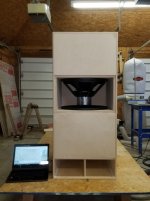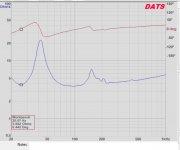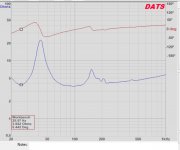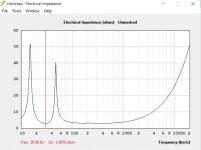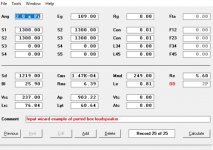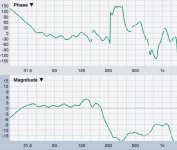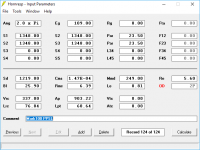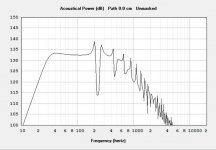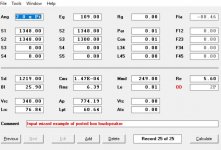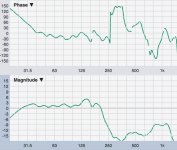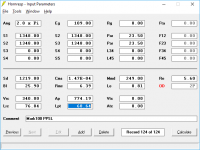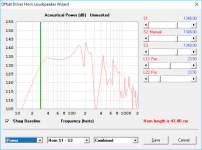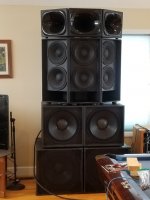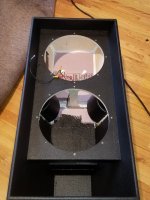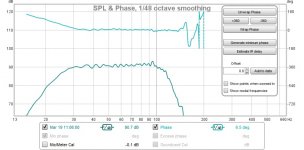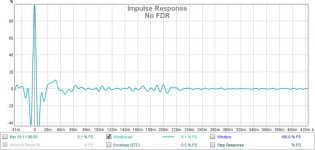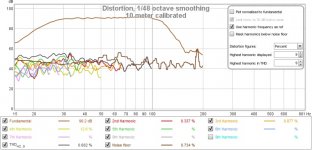As I have stated, not a fan of harmonic distortion in reproduction systems. In fact, years ago I shifted from using small horn loaded subs to ported long-excursion subs specifically to reduce LF distortion..../QUOTE]
Hey, Art.
I'm a bit confused. I thought Horns had significantly LESS odd order distortion.
I've even been considering some kind of smallish horn with two PPSL loaded drivers.
Of course, I still don't know if I'll prefer extra clean to having some odd-order harmonics, which is another issue entirely.
Can you elaborate on your findings & thoughts?
-------
You have not yet heard a PP sub, yet seem to argue that a reduction of even order leaving primarily odd order harmonics will sound better.
Please don't put words in my mouth! I very specifically did NOT say "will." This is subjective. What I know for sure is that if I add even order harmonics to a mix, using plugins, it never, EVER sounds good. I also hear that same muddiness in every smallish, ported BR sub I've heard to date. It's reasonable to assume that this is at least part of the problem.
A related question: Do you know if the same even-order distortion occurs, at the same level, in a sealed sub? I loved my old Bag End 18's, although they weren't extremely punchy. If they also had a lot of 2nd order, then that tells me something. - Although perhaps that muddiness was negated by the sealed box's excellent transient response.
Last edited:
What I know for sure is that if I add even order harmonics to a mix, using plugins, it never, EVER sounds good.
I think it depends on how much is being added.
I suspect most people are not going to be able to hear THD up to 10% in the bass region (if that consists primarily of 2nd and 3rd order harmonics), particularly if the signal is full range music, not pure sign waves. Even the type of music being played is going to affect the audibility of distortion at bass frequencies.
Add a large amount of harmonics, and yes, it will be very audible.
1)Reviewing even and odd order distortion components in horns vs sealed or BR I have not seen a specific correlation between type of cabinet and order of distortion. Band pass designs reduce harmonics above the pass band.As I have stated, not a fan of harmonic distortion in reproduction systems. In fact, years ago I shifted from using small horn loaded subs to ported long-excursion subs specifically to reduce LF distortion..../QUOTE]
Hey, Art.
1)I'm a bit confused. I thought Horns had significantly LESS odd order distortion.
I've even been considering some kind of smallish horn with two PPSL loaded drivers.
2)Of course, I still don't know if I'll prefer extra clean to having some odd-order harmonics, which is another issue entirely.
Can you elaborate on your findings & thoughts?
3) Do you know if the same even-order distortion occurs, at the same level, in a sealed sub? I loved my old Bag End 18's, although they weren't extremely punchy. If they also had a lot of 2nd order, then that tells me something. - Although perhaps that muddiness was negated by the sealed box's excellent transient response.
2) I have elaborated previously regarding PP:
Push Pull vs Normal Distortion Compared
Some comparison between distortion in post 12:
Keystone Sub Using 18, 15, & 12 Inch Speakers
Data Bass has loads of testing on various sub drivers and designs, few (if any)PP:
Data-Bass
3)Bag End has made many different 18" sealed cabinets over the four decades or so they have been around, so I don't know which you love. Their "Infra" series use frequency related limiting to limit the driver's excursion, which also keeps distortion (and output) at low levels.
Distortion of even and odd orders occur in any design, though PP reduces even order in any design.
Last edited:
bms 18n862, 340L, 49" x 21.75" x 31.5" D
120 sq in port, 24" deep.
Port is still adjustable..awaiting outdoor ground plane measurement...
Stoked !
Thx to all, especially djk, for this thread, this build...
How does that measured impedance compare to the sim?
Both DATS and Hornresp can export impedance data to ZMA files, and these can be imported into REW for comparison purposes.
How does that measured impedance compare to the sim?
Both DATS and Hornresp can export impedance data to ZMA files, and these can be imported into REW for comparison purposes.
My DATS impedance minimum is a little lower that hornResp 30Hz.
But I have no idea if I modeled right....input screen is below...
Any observations/corrections , good or bad , appreciated...
Attachments
My DATS impedance minimum is a little lower that hornResp 30Hz.
But I have no idea if I modeled right....input screen is below...
Any observations/corrections , good or bad , appreciated...
The phase is 0 degrees at around 30 Hz, so it looks like target Fb was achieved. What's happening between 100 Hz and 200 Hz though suggests that your model isn't complete (looks like the effect of the plenum needs to be included in the model). What's the depth of the plenum and how far from the closed end are the center of the drivers located?
Another thing is that your minimum impedance is significantly higher than the Hornresp sim. Do you have any stuffing in the box? If not, I suggest recalibrating the DATS.
My DATS impedance minimum is a little lower that hornResp 30Hz.
But I have no idea if I modeled right....input screen is below...
Any observations/corrections , good or bad , appreciated...
to factor in the plenum effects, should probably use PAR segments with actual lengths. this may help your sim better correlate with your measured results
The phase is 0 degrees at around 30 Hz, so it looks like target Fb was achieved. What's happening between 100 Hz and 200 Hz though suggests that your model isn't complete (looks like the effect of the plenum needs to be included in the model). What's the depth of the plenum and how far from the closed end are the center of the drivers located?
Another thing is that your minimum impedance is significantly higher than the Hornresp sim. Do you have any stuffing in the box? If not, I suggest recalibrating the DATS.
Getting Fb close was about all I was shooting for, beyond matching the volume and port size I used very happily on single BR's with the same drivers.
The box doesn't have any stuffing. The plenum is 11" high, about as short as I could make it. Depth is 18.5" Width 19. Pretty much as small as I could make them.....
I recalibrated DATS...same results. DCR looks spot on, just for checking..
So yeah, something with the plenum interaction I guess...I really can't stress enough the that OD entry I put in hornResp is purely my non-understanding monkey-saw-it-somewhere, attempt at going beyond a BR model...
I don't want to get too concerned trying matching sims to measurements....mainly because I found three sets of TS for the driver,... BMS, data-bass, and voice coil, and they all differed enough that I'm like 'what the heck is the value in dissecting sims past a certain smell test point'
But I would like to learn how to model the plenum....I know it has a LP effect but that's about it..
I have to say, I've never heard such a muted DATS sweep, once above sub frequencies...hey, gonna go make a raw freq response measurement.......
Ok, I just took a mic-on-floor, in-room raw measurement just to get an idea of what plenum does as far as a LPF...wow, does alot IMO.
Can't wait to make some legit outdoor groundplane measurements..
Attachments
Last edited:
The box doesn't have any stuffing. The plenum is 11" high, about as short as I could make it. Depth is 18.5" Width 19. Pretty much as small as I could make them.....
I recalibrated DATS...same results. DCR looks spot on, just for checking..
So yeah, something with the plenum interaction I guess...I really can't stress enough the that OD entry I put in hornResp is purely my non-understanding monkey-saw-it-somewhere, attempt at going beyond a BR model...
The attached pic should be a closer match to what you built...
Attachments
The attached pic should be a closer match to what you built...
Thank you Brian, your inputs page looks closer....rolling off steeply at 200Hz as in my quick and nasty measurement.
My measurement pretty much stays down in response after 200Hz to 400Hz anyway, where the sim doesn't ????
Oh, my apologies ...the input page I posted was in contemplation of raising the port an inch....below is an accurate input as far as the cabinet as is, as a dual BR, with your plenum corrections..
Attachments
Thank you Brian, your inputs page looks closer....rolling off steeply at 200Hz as in my quick and nasty measurement.
My measurement pretty much stays down in response after 200Hz to 400Hz anyway, where the sim doesn't ????
Oh, my apologies ...the input page I posted was in contemplation of raising the port an inch....below is an accurate input as far as the cabinet as is, as a dual BR, with your plenum corrections..
Nope, the plenum isn't described properly in that sim. The length of the S1-S2 and S2-S3 segments is incorrect. See corrected version below.
Above 200~300 Hz, the response is much more influenced by the driver's FR, so the Hornresp sim is more inaccurate in that range.
Attachments
BTW , 774 cm^2 of vent area seems a bit... small for two 18" drivers like those in a box aimed at PA duty, though it does help to keep box size down, I guess. When I designed my POC6, I designed an MLTL with vent area = 2/3rd Sd for a 12" driver with 5mm Xmax, and I was still seeing 1~2dB of vent compression around the vent resonance frequency.
Have you done any linearity tests on your build...?
Have you done any linearity tests on your build...?
BTW , 774 cm^2 of vent area seems a bit... small for two 18" drivers like those in a box aimed at PA duty, though it does help to keep box size down, I guess. When I designed my POC6, I designed an MLTL with vent area = 2/3rd Sd for a 12" driver with 5mm Xmax, and I was still seeing 1~2dB of vent compression around the vent resonance frequency.
Have you done any linearity tests on your build...?
Thx for new sims, plenum inputs are starting to make sense....
Linearity tests? I wish lol..
This project is barely a week old
like said yesterday, I don't even have a good outdoor ground plane transfer yet (I don't trust indoor sub measurements much if any)
The box has just made it into the stage of play with the port and see how measurements respond. It's built to be able to adjust vent size and depth fairly easily.
I doubt I'll go over 45% of SD, and am very curious about your box built to 2/3 SD.
I've looked at 18" sub designs recommended by 18sound, B&C, and RCF. Some of 18sound's designs approach 50%, but B&C and RCF's are way lower, more in the 25% zipcode.
How do you do your compression tests? Comparative REW sweeps?
If so what duration, and can you set the sweep voltages reasonably well?
Been thinking about trying this.....
Thx for new sims, plenum inputs are starting to make sense....
Linearity tests? I wish lol..
This project is barely a week old...
Hah, I was doing linearity tests on my last build the same day the driver was bolted into the box
Seriously, the build (POC6 - see link below) was basically done to test a few things, including if it's possible to get better results simming and building a speaker with a large vent as an MLTL rather than a vented box, and the results seem to bear that out. When a vent gets larger, it also gets longer for the same Fb, and pretty soon its pipe resonances start falling in the passband. Sim the box as an offset MLTL and you can eliminate the problems caused by the lowest resonance by choosing the right box dimensions and location for the driver. Unfortunately the box gets bigger though (the larger vent of course occupies more space).
Here's the link: The Subwoofer DIY Page v1.1 - Projects : Proof of Concept #6
How do you do your compression tests? Comparative REW sweeps?
Basically I use the most powerful amp I can get my hands on (currently my car audio amp that can generate 1.2kW into 4 ohms) with no EQ, and feed the speaker at different levels until I get the results I'm looking for. I'm constantly tweaking the process, but this is the last method I used:
1. Use REW for measurement, and use a SHORT sine sweep at -6dB starting from at or just below Fb up to 200 Hz (or wherever I want to cut it off), upping the gain on the amp and keeping an eye on the measurement until the distortion in the passband hits around 10% (or the speaker starts to sound distressed). Make sure your mike is far enough away so it doesn't contribute significantly to the distortion.
2. Disconnect the speaker and measure the output voltage from the amp when driven with a 50~60 Hz -6dB sine wave from REW.
3. Reconnect the speaker and repeat the measurement process again using REW and SHORT sine sweeps, this time leaving the amp's gain unchanged and starting the measurement signal from -30dB or -24dB (your choice) and increasing it in 1~3dB steps.
4. Use REW to compare the results.
Note - this is a good way to find the best HP filter for the build too. Just monitor the distortion that the speaker generates below Fb, and set the HP filtering (and possibly EQ around Fb) so it doesn't get excessive as the volume is increased. My POC6 was designed to take advantage of my car deck's poxy 20 Hz, 30 Hz and 50 Hz EQ bands for this purpose (20 Hz and 30 Hz bands dropped as low as possible, 2dB added at 50 Hz to restore the gain lost there). Now I don't have to worry about what doofus plays through my portable PA system while I'm off having a few drinks
Hah, I was doing linearity tests on my last build the same day the driver was bolted into the box. I wasn't going to do any finishing to it until I confirmed that it performed as expected.
Seriously, the build (POC6 - see link below) was basically done to test a few things, including if it's possible to get better results simming and building a speaker with a large vent as an MLTL rather than a vented box, and the results seem to bear that out.
Now I don't have to worry about what doofus plays through my portable PA system while I'm off having a few drinks
I sure wish my box was as easy to move around as yours, along with your weather!
Getting 180lbs out on a driveway full of snow keeps linearity tests on hold
I don't really understand transmission lines, but a couple of guys who looked at some mid boxes i recently built say they are of that ilk.
Pls note the increasing stepped depth from top driver down to the vent. Would you call that a TL ?
Those are the boxes I need to figure out subs for.
The drivers for the PPSL came out of the sealed 18's.
The PPSL will be able to directly compare to the vented 18's,
using the same drivers with very similar BR volume/port design.
So far freq response looks near identical between the PPSL and the vented 18's.. they do sound a wee bit different though...more to determine...
Thanks for instructions on using REW for compression.
I've been using Smaart for compression,which is maybe a little easier, because you can compare traces real time just using pink. But smaart doesn't do harmonic distortion, so I've been thinking about using REW and do compression and distortion at same time.
Biggest problem is the whoop sound of REW blasting through the neighborhood (vs less noticeable pink noise ) when I'm putting 3-6kW on the boxes !!
Totally with you on making things doofus proof and drink-time ready
Attachments
Had a chance to get a basic outdoor ground plane measurement today on the PPSL I've posted.
The port shelf is just screwed in place for response verification, and it started to audibly flap around the 30 Hz neighborhood, when I raised levels to 120dB, so I didn't crank it any.
Add 20dB to the traces, as measurements were taken at 10 meters.
So about 110dB @ 1m for these plots......
Processing includes high-pass @25 Hz Bu4, and low-pass @ 120 Hz LR16.
Default 1/48th smoothing, and no FDW on any.
Happy camper so far !
The port shelf is just screwed in place for response verification, and it started to audibly flap around the 30 Hz neighborhood, when I raised levels to 120dB, so I didn't crank it any.
Add 20dB to the traces, as measurements were taken at 10 meters.
So about 110dB @ 1m for these plots......
Processing includes high-pass @25 Hz Bu4, and low-pass @ 120 Hz LR16.
Default 1/48th smoothing, and no FDW on any.
Happy camper so far !
Attachments
How does this look as a sub?
My subs should be here this week,
Creative Sound Solutions | High End Speakers and Speaker Kits
Parameters.
Fs 21.3 hz
Senstitivity 87.2 @ 2.83V/1M
Mms 275.9 g
BL 18.4 N/A
Cms 0.276 mm/N
Vas 67.5 L
Qms 3.962
Qes 0.414
Qts 0.374
Nom Imp 4 ohm
Re 3.7 ohm
Le 1.38 mH
Xmax 28 MM
Sd 491 cm^2
Dimensions,
Outside Diameter 312 mm
Cutout Diameter 277 mm
Depth 225 mm
Sealed box looks like it should be 1.84'^3 before drivers and slot.
Slot opening looks like it should be ~6"x12" wide (1/2 total SD, 76"^2) and I guess about 12" deep. How do you install a 9" deep sub in a 6" opening? I was going to leave the plenum square as I am not looking for higher extension.
I was going to leave the plenum square as I am not looking for higher extension.
The plate amp I have is 800 watts at 8 ohms (plan was to wire drivers out of phase in series) and use a 6db gain at 30hz (amp has 5 point variable PEQ) to get an F3 of around 27 hz (my hope was the PPSL design would lower the F3). I have an Omnimic and REW to hopefully EQ it correctly.
Thoughts on this plan? Do I have the basics correct for a PPSL sub? Or am I out to lunch?
My goal was the most sub in the smallest space.
Plan B is to build a M&K clone...
Thank you,
David, London, Canada
My subs should be here this week,
Creative Sound Solutions | High End Speakers and Speaker Kits
Parameters.
Fs 21.3 hz
Senstitivity 87.2 @ 2.83V/1M
Mms 275.9 g
BL 18.4 N/A
Cms 0.276 mm/N
Vas 67.5 L
Qms 3.962
Qes 0.414
Qts 0.374
Nom Imp 4 ohm
Re 3.7 ohm
Le 1.38 mH
Xmax 28 MM
Sd 491 cm^2
Dimensions,
Outside Diameter 312 mm
Cutout Diameter 277 mm
Depth 225 mm
Sealed box looks like it should be 1.84'^3 before drivers and slot.
Slot opening looks like it should be ~6"x12" wide (1/2 total SD, 76"^2) and I guess about 12" deep. How do you install a 9" deep sub in a 6" opening?
The plate amp I have is 800 watts at 8 ohms (plan was to wire drivers out of phase in series) and use a 6db gain at 30hz (amp has 5 point variable PEQ) to get an F3 of around 27 hz (my hope was the PPSL design would lower the F3). I have an Omnimic and REW to hopefully EQ it correctly.
Thoughts on this plan? Do I have the basics correct for a PPSL sub? Or am I out to lunch?
My goal was the most sub in the smallest space.
Plan B is to build a M&K clone...
Thank you,
David, London, Canada
Creative Sound Solutions | High End Speakers and Speaker Kits
Slot opening looks like it should be ~6"x12" wide (1/2 total SD, 76"^2) and I guess about 12" deep. How do you install a 9" deep sub in a 6" opening?
Hi David,
width and depth obviously have to accommodate the diameter of the driver, plus a little wiggle room. Looking at your driver with its 12 9/32 diameter, I'd call that a minimum of about 12 3/4 x 12 3/4.
Height has to be the height of the driver, plus the thickness of the driver's mounting flange, plus a little wiggle room to be able to slide the inverted driver into place.....
so 8 3/4 driver H, plus 11/16 flange, plus 1/4 wiggle...
... about 8 31/32 minimum height IMO...
make sense? best, Mark
- Status
- This old topic is closed. If you want to reopen this topic, contact a moderator using the "Report Post" button.
- Home
- Loudspeakers
- Subwoofers
- A Thread for those interested in PPSL enclosures
